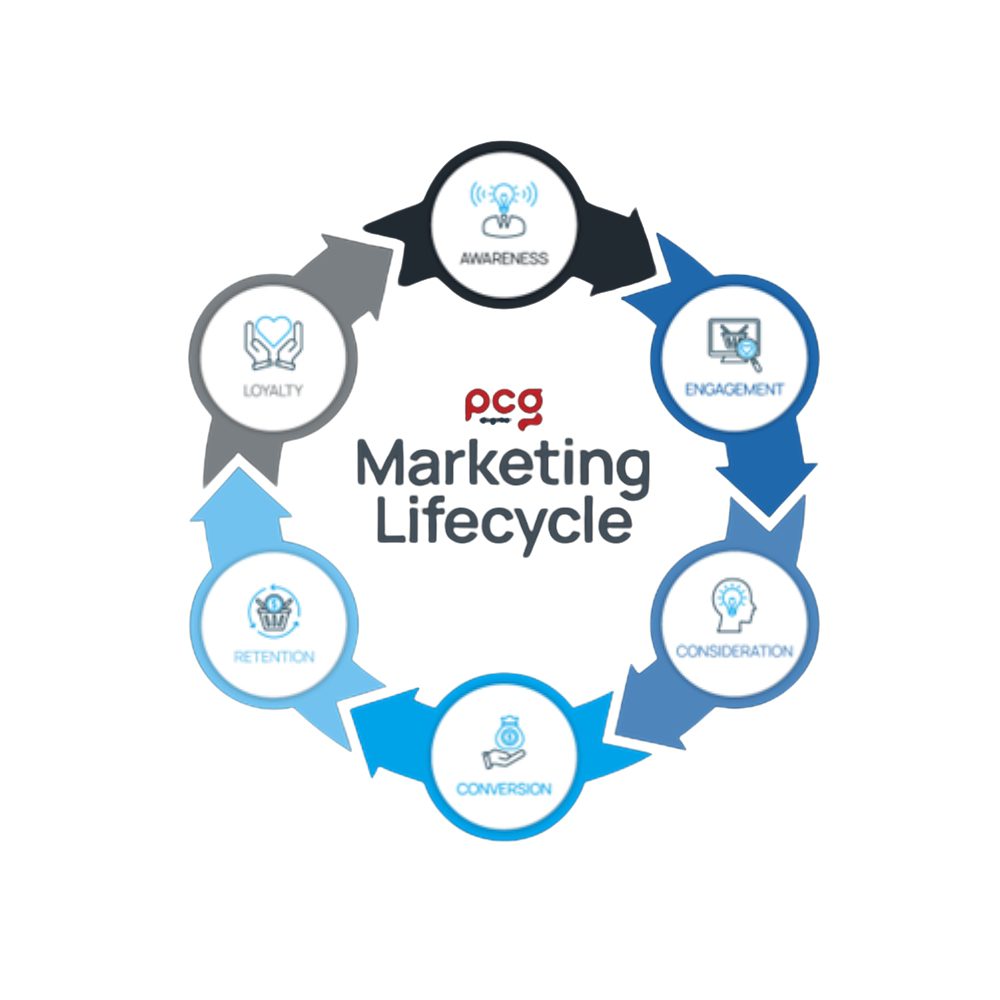Lifecycle marketing is a crucial strategy for automotive dealers aiming to build long-term success and cultivate lasting relationships with their customers. By implementing lifecycle marketing into their digital strategies, dealerships can engage with shoppers at every stage of their journey—whether they’re in the research phase, ready to purchase, or considering post-sale services.
This personalized, data-driven approach ensures that each interaction is relevant, timely, and valuable, which not only enhances customer satisfaction but also boosts retention rates and drives repeat business. In an increasingly competitive market, leveraging lifecycle marketing allows automotive dealers to establish trust, nurture relationships, and position themselves as the go-to source for their customers’ automotive needs, ensuring sustained success and growth.
This article will explore each phase of the lifecycle marketing loop and corresponding digital strategies any automotive marketer can implement for their dealership.


Phase I – Awareness
The awareness phase of the Lifecycle Marketing Loop is where potentially qualified shoppers are introduced to your brand for the first time. They may already know your OEM brand (Ford, Nissan, Chevy, Kia, etc.) but haven’t had the chance to connect with your dealership brand. The awareness phase is an opportunity to capture shoppers’ attention and distinguish what sets you apart from competing dealerships. This phase is often noted as key to helping customers move to the next step of deciding who to do business with.
If done well, eventually, the customer will submit their information, which then allows further personalized marketing. This part of the lifecycle marketing loop is also where dealers can emphasize what sort of problem they can solve for a shopper. Dealers need to be confident in their messaging, tone, style, values, and culture, as these elements are all reflected in their awareness-stage marketing.
Remember, these elements need to be compliant with standards for your OEM but differentiated enough for the dealership to stand out from the competition.
Strategy Examples:
- Amazon Advertising
- Streaming/OTT
- Organic content/website blogs/organic Google searches
- Branding campaigns via paid social media
- Search Engine Optimization (SEO)
Phase II – Engagement
As a dealer, the engagement phase of your Lifecycle Marketing Loop provides the opportunity for potentially qualified shoppers to further engage with your brand. Now that they’ve been introduced to your unique value proposition in the awareness phase, you need to strategize ways for them to stay connected. In our evolving digital landscape, online engagement is just as important as an in-person introduction. PCG refers to this phase as creating a “digital handshake”.
Instead of introducing shoppers to your brand and flooding them with conversion-based advertising, the most successful brands (yes, your dealership is a brand) provide opportunities for continued connection as a natural and progressive next step to continuing a conversation.
Maintaining consistent messaging across your digital efforts and website is essential for delivering a seamless online customer experience and ensuring continued engagement from shoppers.
Strategy Examples:
- Organic Social Media
- Paid Social Media | Incentive traffic campaign
- LinkedIn Display Ads
- Video Marketing (YouTube or Social Media Videos)
Phase III – Consideration
The consideration stage of the Lifecycle Marketing Loop, oftentimes referred to as the “evaluation phase”, is all about shoppers making decisions. The dealer’s goal here is to provide shoppers with marketing efforts that include the right information at the right time. At this point, shoppers decide whether to bring business to you (like visiting your website) and are often comparing things like pricing, inventory, and deciding factors between you and your competition.
During this phase, a dealer’s content is the ultimate driver of a shopper’s willingness to convert with them. In addition to educating shoppers about what their particular dealership can provide, dealers should also focus on enforcing trust. Remember, in 2025, shoppers don’t want to buy from anyone, they want to buy from a dealer they can relate to, trust, and support.
How are you showcasing this in your advertising? Why is your dealership the best option in the market?
Strategy Examples:
- Personalized email campaigns
- Retargeting Ads on Google, Microsoft, Meta, and TikTok
- Dynamic Inventory Advertising
- Dynamic Search Campaigns
- Vehicle Listing Ads
- Special Offers and Incentives
- Customer Testimonials and Reviews
- Messenger Campaigns
- Social Media Engagement
Phase IV – Conversion
The conversion stage of the Lifecycle Marketing Loop is where the customer is ready to connect with the dealership’s team. The customer is looking for assistance with all of their questions or information they accumulated in their research phase. The dealer needs to make sure there are no obstacles causing friction during this outreach. Some friction points could be website pop ups, too many forms and delayed responses to their questions.
Dealers should always evaluate their digital retailing efforts and mystery shop their websites to ensure they’re providing customers with an easy way to communicate with them. In addition, dealers should be able to connect with shoppers on all platforms – form fills and phone calls shouldn’t be the only avenues of communication between you and a buyer. Most dealers fail at this part of the cycle because they don’t offer shoppers the opportunity for seamless conversation.
Strategy Examples:
- Limited time offers
- Hyper-targeted retargeting campaigns
- Personalized Email Campaigns
- Scheduling a test drive campaign
- Messenger/chat tool interaction-based campaigns
- Finance and leasing offers
One of the biggest areas for improvement in dealerships is their sales outreach process. Too often, the focus is solely on getting the customer into the dealership as quickly as possible. While this approach may work for the small percentage of customers who are ready to buy immediately, it alienates those who are still in the research phase—which, in many cases, is a large part of the customers who submit their information.
Focus the strategy on beginning a conversation. The strategy for an in-person customer revolves around asking questions to move the process forward. Unfortunately, this does not happen for the online customer, who is only asked when they would like to come in to test drive.
Data from Urban Science shows a large number, over 50% of customers in a dealership’s CRM purchase after 8 days from submitting their information. If the dealership’s process is focused on only the immediate first three days from submission, very short-term focused, it is pushing customers away and possibly defecting to a different dealership.
Shifting from short-term follow-up to a more conversational approach to understand where the customer is on their purchase journey, allows more customer sales, which leads to higher customer retention opportunities
Phase V – Retention
The retention stage of the Lifecycle Marketing Loop is all about keeping your customers happy once they’ve chosen you. Dealers often take this stage of marketing for granted. So much focus from the OEM is on new car sales, it is easy to assume customers will return for service.
It’s important to stay connected with your customers long after the transaction. The coming years for potential service visits are often 4X or 10X opportunities to sell another vehicle. It is necessary to have a proactive marketing plan to focus on these specific customer’s needs at the right time to protect from customer defection to independent service companies. The strategy in this stage is to follow up with customers, make sure they’re satisfied with their purchase, and proactively remind them of upcoming maintenance when necessary. This is a very targeted phase of the loop, and should not include broader and more general strategies – speak to these customers digitally as if you’re speaking to them face to face.
Strategy Examples:
- Personalized Email Campaigns (Post-Purchase Follow-ups)
- Loyalty Programs & Rewards
- Scheduled Service Reminders
- Exclusive Offers for Existing Customers
- Targeted Social Media Engagement
- Re-Engagement Campaigns
- Automated Service Appointment Booking
As technology begins to aggregate better customer data profiles, there are now even more opportunities to help consumers when they are looking for assistance. While proactive messaging, based on when a customer is scheduled for services, what are they returning to the website, but not submitting their information?
With the expansion of Customer Data Platforms (CDP), we now can see when customers return to the website, what they are looking at and can make a personal outreach as needed. For example, what if a dealership could reach out to those customers who started to schedule a service appointment but did not complete the process? Maybe it was the technology on the website or some other reason, but if the dealership staff could reach out to assist, how many more customers would be retained and impressed by this helpful process?
Retaining customers is key to a dealership’s long-term success. These strategies can help to grow loyal followers and advocates for the dealership.
Phase VI – Loyalty
The loyalty stage of the Lifecycle Marketing Loop is where happy customers live. At this juncture, dealers should provide opportunities for the customer to share their positive experience(s) with the dealership. Nurture the advocacy and allow these customers to be word-of-mouth advertising for anyone who has yet to be introduced to your brand (thus looping back to the awareness stage).
Long-term, happy customers create a sense of credibility and community for current and new shoppers alike, so emphasizing this phase can ultimately enhance your entire Lifecycle Marketing Loop! Don’t forget to use these testimonials in the dealership’s marketing to reinforce claims made in the awareness phase.
Strategy Examples:
- Word-of-mouth
- Organic Facebook Events
- Event Engagement Ads on Meta
- Community Involvement
Adopting a lifecycle marketing digital approach is essential for automotive dealers looking to build long-term relationships with their customers, enhance engagement, and drive sustained business growth. By aligning your strategies with each phase of the customer journey, from awareness to loyalty, you can ensure that your dealership stays top of mind and continuously meets the evolving needs of car buyers.



